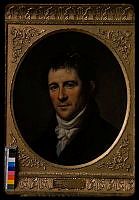Benjamin Henry Boneval Latrobe, White House Collection
This portrait by Charles Willson Peale is of architect Benjamin Henry Latrobe. President Thomas Jefferson appointed Latrobe Surveyor of Public Buildings in 1803. Latrobe is best known as the architect who designed the U.S. Capitol, St. John's Church and Decatur House in Lafayette Square, the White House East and West Terraces, and the Madison state rooms. He was also the chief engineer for the U.S. Navy. Peale was a soldier and inventor as well as an artist and created many portraits of Revolutionary War era figures. His younger brother, James, and his son Rubens, each have pieces in the White House Collection. Joseph H. Bailey photographed the portrait for the White House Historical Association's records and publications in January 1975.







